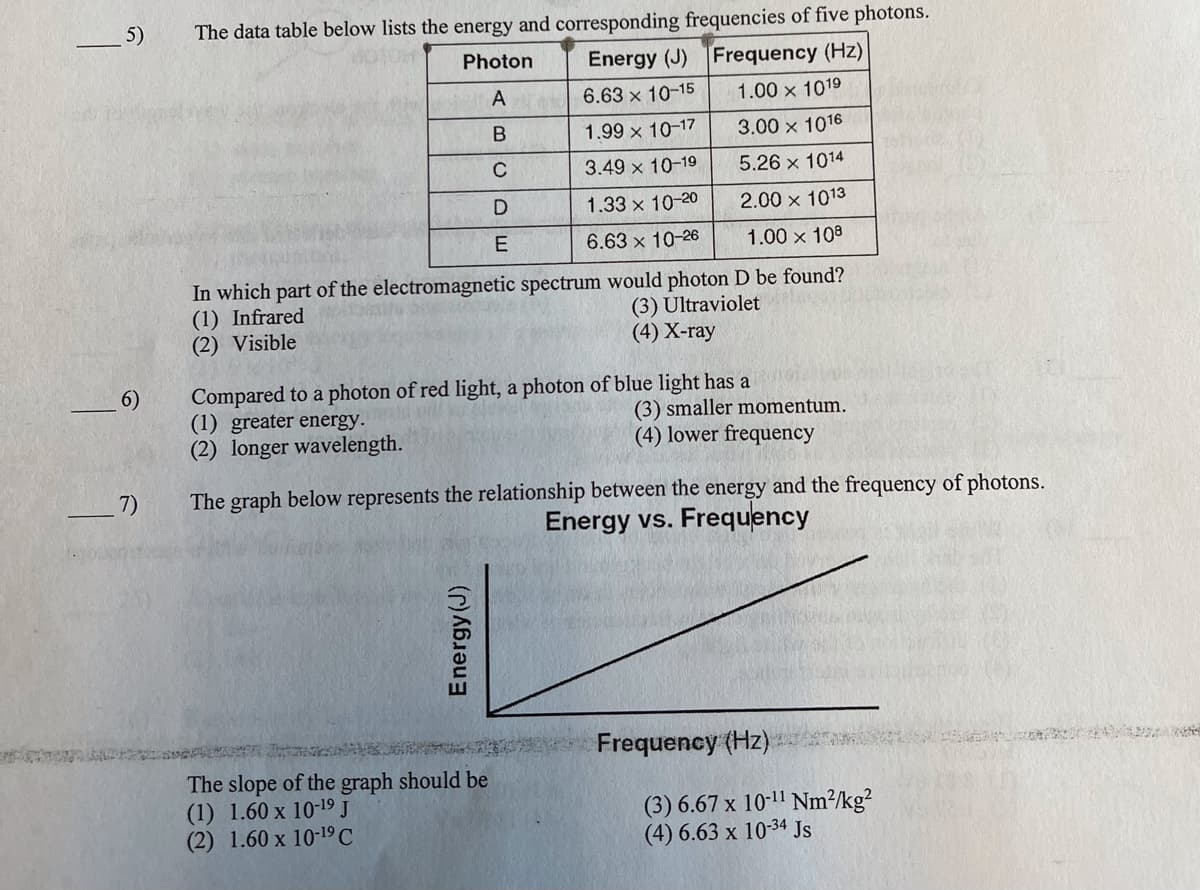5) The data table below lists the energy and corresponding frequencies of five photon Photon Frequency (Hz) Energy (J) 6.63 x 10-15 A 1.00 x 1019 B 1.99 x 10-17 3.00 x 1016 C 3.49 × 10-19 5.26 x 1014 D 1.33 x 10-20 2.00 x 1013 E 6.63 x 10-26 1.00 × 108 In which part of the electromagnetic spectrum would photon D be found? (1) Infrared (3) Ultraviolet (4) X-ray (2) Visible 6) Compared to a photon of red light, a photon of blue light has a (1) greater energy. (3) smaller momentum. (4) lower frequency (2) longer wavelength. 7) The graph below represents the relationship between the energy and the frequency of photons. Energy vs. Frequency Frequency (Hz) The slope of the graph should be (1) 1.60 x 10-19 J (2) 1.60 x 10-19 C Energy (J) (3) 6.67 x 10-¹1 Nm²/kg2 (4) 6.63 x 10-34 Js
5) The data table below lists the energy and corresponding frequencies of five photon Photon Frequency (Hz) Energy (J) 6.63 x 10-15 A 1.00 x 1019 B 1.99 x 10-17 3.00 x 1016 C 3.49 × 10-19 5.26 x 1014 D 1.33 x 10-20 2.00 x 1013 E 6.63 x 10-26 1.00 × 108 In which part of the electromagnetic spectrum would photon D be found? (1) Infrared (3) Ultraviolet (4) X-ray (2) Visible 6) Compared to a photon of red light, a photon of blue light has a (1) greater energy. (3) smaller momentum. (4) lower frequency (2) longer wavelength. 7) The graph below represents the relationship between the energy and the frequency of photons. Energy vs. Frequency Frequency (Hz) The slope of the graph should be (1) 1.60 x 10-19 J (2) 1.60 x 10-19 C Energy (J) (3) 6.67 x 10-¹1 Nm²/kg2 (4) 6.63 x 10-34 Js
Related questions
Question
This is a multiple question with 4 parts so all parts need to be answered & not against community guidelines. You can just give me the number of the question and the letter of the answer that goes with it.

Transcribed Image Text:5)
The data table below lists the energy and corresponding frequencies of five photons.
Photon
Frequency (Hz)
Energy (J)
6.63 x 10-15
At
1.00 × 1019
B
1.99 x 10-17
3.00 x 1016
C
3.49 x 10-19
5.26 x 1014
D
1.33 x 10-20
2.00 × 1013
E
6.63 x 10-26
1.00 x 108
In which part of the electromagnetic spectrum would photon D be found?
(1) Infrared
(3) Ultraviolet
(4) X-ray
(2) Visible
6)
Compared to a photon of red light, a photon of blue light has a
(1) greater energy.
(3) smaller momentum.
(2) longer wavelength.
(4) lower frequency
7)
The graph below represents the relationship between the energy and the frequency of photons.
Energy vs. Frequency
Frequency (Hz)
The slope of the graph should be
(1) 1.60 x 10-19 J
(2) 1.60 x 10-¹⁹ C
Energy (J)
(3) 6.67 x 10-¹1 Nm²/kg²
(4) 6.63 x 10-34 Js
Expert Solution
This question has been solved!
Explore an expertly crafted, step-by-step solution for a thorough understanding of key concepts.
This is a popular solution!
Trending now
This is a popular solution!
Step by step
Solved in 2 steps with 1 images
